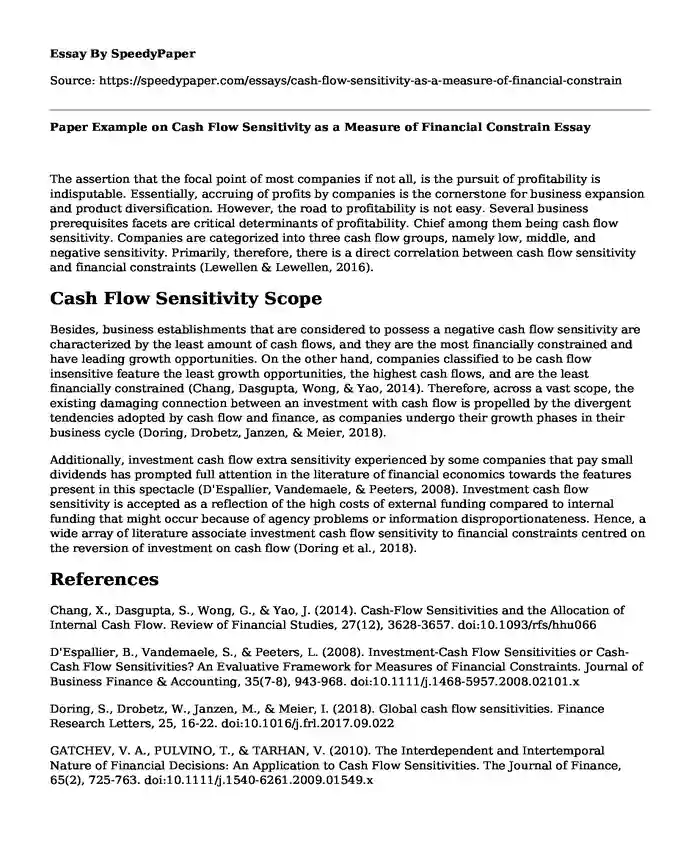The assertion that the focal point of most companies if not all, is the pursuit of profitability is indisputable. Essentially, accruing of profits by companies is the cornerstone for business expansion and product diversification. However, the road to profitability is not easy. Several business prerequisites facets are critical determinants of profitability. Chief among them being cash flow sensitivity. Companies are categorized into three cash flow groups, namely low, middle, and negative sensitivity. Primarily, therefore, there is a direct correlation between cash flow sensitivity and financial constraints (Lewellen & Lewellen, 2016).
Cash Flow Sensitivity Scope
Besides, business establishments that are considered to possess a negative cash flow sensitivity are characterized by the least amount of cash flows, and they are the most financially constrained and have leading growth opportunities. On the other hand, companies classified to be cash flow insensitive feature the least growth opportunities, the highest cash flows, and are the least financially constrained (Chang, Dasgupta, Wong, & Yao, 2014). Therefore, across a vast scope, the existing damaging connection between an investment with cash flow is propelled by the divergent tendencies adopted by cash flow and finance, as companies undergo their growth phases in their business cycle (Doring, Drobetz, Janzen, & Meier, 2018).
Additionally, investment cash flow extra sensitivity experienced by some companies that pay small dividends has prompted full attention in the literature of financial economics towards the features present in this spectacle (D'Espallier, Vandemaele, & Peeters, 2008). Investment cash flow sensitivity is accepted as a reflection of the high costs of external funding compared to internal funding that might occur because of agency problems or information disproportionateness. Hence, a wide array of literature associate investment cash flow sensitivity to financial constraints centred on the reversion of investment on cash flow (Doring et al., 2018).
References
Chang, X., Dasgupta, S., Wong, G., & Yao, J. (2014). Cash-Flow Sensitivities and the Allocation of Internal Cash Flow. Review of Financial Studies, 27(12), 3628-3657. doi:10.1093/rfs/hhu066
D'Espallier, B., Vandemaele, S., & Peeters, L. (2008). Investment-Cash Flow Sensitivities or Cash-Cash Flow Sensitivities? An Evaluative Framework for Measures of Financial Constraints. Journal of Business Finance & Accounting, 35(7-8), 943-968. doi:10.1111/j.1468-5957.2008.02101.x
Doring, S., Drobetz, W., Janzen, M., & Meier, I. (2018). Global cash flow sensitivities. Finance Research Letters, 25, 16-22. doi:10.1016/j.frl.2017.09.022
GATCHEV, V. A., PULVINO, T., & TARHAN, V. (2010). The Interdependent and Intertemporal Nature of Financial Decisions: An Application to Cash Flow Sensitivities. The Journal of Finance, 65(2), 725-763. doi:10.1111/j.1540-6261.2009.01549.x
Lewellen, J., & Lewellen, K. (2016). Investment and Cash Flow: New Evidence. Journal of Financial and Quantitative Analysis, 51(4), 1135-1164. doi:10.1017/s002210901600065x
Cite this page
Paper Example on Cash Flow Sensitivity as a Measure of Financial Constrain. (2023, Feb 08). Retrieved from https://speedypaper.net/essays/cash-flow-sensitivity-as-a-measure-of-financial-constrain
Request Removal
If you are the original author of this essay and no longer wish to have it published on the SpeedyPaper website, please click below to request its removal:
- Free Essay Sample: Education, Health, and Technology
- Comparison Essay Sample: Baraka's Poetry Between the Beat and Islamic Phase
- The Law of Failure Is Misleading - Essay Example in Strategic Marketing
- Essay Sample on the Role of a Masters Prepared Nurse in Inter-professional Practice Settings
- Living With Less Essay Sample
- Amazon and Porter's Diamond Model, Business Essay Example
- Essay Sample on The Star Movie Analysis
Popular categories





